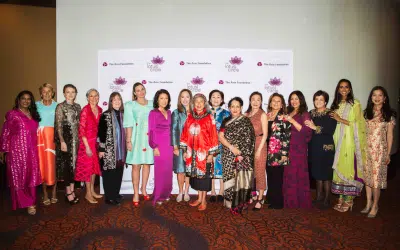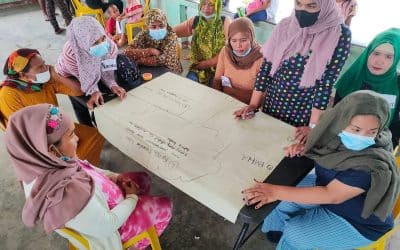InAsia
Insights and Analysis
Lao Citizen Scientists Manage Wetlands Sustainably
November 6, 2019
There were no fish in the Nong Tham Hee wetland in the 2017 dry season. There were none in the 2018 dry season. The people of Nyangkham village, who once fished here year around, saw only cracked, parched earth. Over the years, the water had slowly dwindled, as farmers in the village expanded their rice paddies into the wetlands and disrupted their natural hydrology. It wasn’t until the community got organized that things started to change.

The Nong Tham Hee wetland, in Nyangkham, Laos, after years of agricultural encroachment. Photo: Mouksy Vongsouvath.
Lao PDR (Laos) is rich in natural resources: water and fertile land, timber, metals, gems, and minerals. Laos’s wetlands have long provided its people with a range of benefits, including water for agriculture, fish and wildlife habitat, water purification, and flood mitigation. But this precious endowment is increasingly threatened by unsustainable economic development practices. Among them, the reclamation and conversion of wetlands for agriculture is one of the most significant threats facing natural wetland ecosystems.

The Nong Tham Hee wetland. Photo: Mouksy Vongsouvath.
In the past, resource management in Laos was divided up between different ministries, depending on the type of resource. Development planning was centralized, and water projects were often implemented without local input or deliberation. Over the past decade, however, as pressure on water resources has grown, the government has worked to institute more effective, community-based approaches.
With support from The McConnell Foundation, The Asia Foundation recently worked with the Ministry of Natural Resources and Environment to bring the Community-Based Integrated Water Resource Management Project (CWRM) to three villages in the Xe Bang Fai District of Khammouane Province.
The CWRM project uses Integrated Water Resources Management (IWRM), which emphasizes that competing uses of finite water resources are interdependent and must be managed equitably and systematically. Heavy agricultural use, for example, can mean less fresh water for drinking or industry; industrial wastewater can threaten rivers and wetlands; wetland preservation can mean less land for farming. Attempts to manage these competing uses in isolation fail to address their systematic interdependencies.
CWRM emphasizes bottom-up, participatory mechanisms for water resources management that acknowledge the legitimate interests of competing stakeholders and help communities understand and manage their own water resources, waste management, and the local environment. The project in Xe Bang Fai focused on three principal areas—agriculture, waste management, and wetlands and fisheries. In the CWRM project area, the Napork wetland had been reduced to one-third of its original size by the expansion of rice paddies. The fish catch had declined drastically, and water quality had deteriorated due to agricultural run-off from nearby fields.
To address this unfolding tragedy of the commons, the CWRM project partnered with the affected villages and the government to create a participatory resource management framework. They trained village volunteers, local government staff, teachers, and students to become “citizen scientists,” who began monitoring wetland water quality using macroinvertebrates such as mayflies, midges, water boatmen, and freshwater shrimp.
The project raised earthen embankments around the wetlands to prevent further encroachment and reduce agricultural contamination, and it introduced organic agriculture techniques to the surrounding farms to limit agrochemical runoff. Villagers and local authorities came together to establish consensus rules for legal and illegal fishing practices. In some cases, villagers went a step further and set aside large portions of the wetland for fish conservation.

Nong Tham Hee wetland after enhancement. Photo: Mouksy Vongsouvath.
The villagers had to work through a patchwork of competing interests, such as one Napork farmer who was unwilling to return parts of his paddy fields to the wetlands. “Some people may want to eat fish,” he said, “but I want to eat rice.” So, a compromise was eventually struck: the project created natural barriers around the remaining wetlands to prevent further encroachment, and the farmer kept the additions to his fields. This is what CWRM seeks to achieve: a practical system of cooperative, local resource management that addresses the needs of all users.
In Nyangkham village, the CWRM project supported the restoration and regeneration of the degraded wetland—building embankments, digging deeper pools for fish in the dry season, and restoring the channels that connect the wetlands with the Xe Bang Fai River.
And the villagers of Nyangkham are proud of the results.
“Since the village’s wetland was improved,” says the village head, “there is water in the wetland all year around, so there is an abundance of fish even in the dry season.”
All the villagers know the rules to protect the wetlands and the fish in the wetlands,” said a member of the Nyangkham Wetland Committee. “Since we have put the wetland management regulations in place, we have not found any villagers who have violated the rules.”

Nong Tham Hee wetland in Nyangkham village after enhancement. The villagers have erected a sign declaring parts of the wetland off limits for fishing. Photo: Mouksy Vongsouvath.
While the CWRM project provided technical expertise, the real success lies in the villagers banding together as citizen scientists to manage their wetlands systematically and sustainably for all stakeholders. It underscores the interconnectedness of water management among competing users and the importance of an inclusive, equitable, and participatory approach that considers both environmental and socioeconomic needs.
As Laos and the rest of Asia continue to grow and develop, water supplies and other natural resources will come under increasing stress. Sustainable management practices that allow competing stakeholders to both benefit from and protect these natural resources will be vital to future prosperity.
Tassaya (Toffy) Charupatanapongse is a program associate in The Asia Foundation’s Resource Development Department, and Derin Henderson is director of The Asia Foundation’s Environment Program in Laos. They can be reached at [email protected] and [email protected] respectively. The views and opinions expressed here are those of the authors, not those of The Asia Foundation.
About our blog, InAsia
InAsia is posted and distributed every other Wednesday evening, Pacific Time. If you have any questions, please send an email to [email protected].
Contact
For questions about InAsia, or for our cross-post and re-use policy, please send an email to [email protected].The Asia Foundation
465 California St., 9th Floor
San Francisco, CA 94104
The Latest Across Asia
News
April 25, 2024
Program Snapshot
April 18, 2024
News
April 17, 2024

2024 Lotus Leadership Awards
The Lotus Leadership Awards recognize contributions towards gender equality in Asia and the Pacific







0 Comments